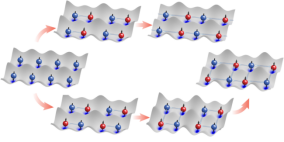A milestone for optical-lattice quantum computing has been achieved recently. The research team, including IIIS associate professor Xiongfeng Ma and collaborators from the University of Science and Technology of China (USTC) and Fudan University (FDU), created a scalable multipartite entanglement in the laser trap for ultracold atoms. This research has been published by Physical Review Letters and circulated widely in Chinese and foreign media.
Entanglement is the key resource for quantum information science. For instance, the computing power of quantum computers may grow exponentially with the increase of entangled qubits. Yet, previous works hit the bottleneck in connecting entangled pairs and testing multipartite entanglement due to the constraints in single-atom qubit control techniques and methods for determining multipartite entanglement.
To overcome the obstacle, Prof. Ma’s research team set the goal with collaborators to create and test multipartite entanglement in ultracold atomic optical lattices, which are considered an excellent platform for preparing multipartite entanglement and processing quantum information due to their reliability and precision in quantum control. However, this system faces challenges both theoretically and experimentally.

Figure 1: Quantum gas microscope and multipartite entangled states in optical lattices,
provided by the University of Science and Technology of China.
Based upon long-term exploration into the fundamental theories and applications of quantum entanglement, Prof. Ma’s research team worked closely with collaborators and proposed theoretical schemes for entanglement preparation and measurement by extending the definition of stabilizer states. These theoretical works have laid a solid foundation for improving atomic entanglement fidelity, atomic parallel control capacity, and conducting quantum computing research.

Figure 2: Experimental preparation process for 1D and 2D entanglement,
provided by the University of Science and Technology of China.
The newly published work successfully prepared atomic two-dimensional arrays with a unity filling state as high as 99.2%. It selected 49 pairs of atoms to prepare highly entangled Bell states, with an average fidelity rate of 95.6% and a lifetime of 2.2 seconds, all of which are at the forefront of the world. At the same time, the project used entanglement gate technology to connect neighboring entangled pairs, successfully preparing a 10-atom one-dimensional entanglement chain and an 8-atom two-dimensional entanglement block for the first time. This is a crucial step towards preparing and manipulating large-scale quantum entanglement.
The research Scalable Multipartite Entanglement Created by Spin Exchange in an Optical Lattice is published in Physical Review Letters. It has been reported by the Xinhua News Agency, the American Physical Society’s Physics Magazine, and many other media.
Paper link: https://journals.aps.org/prl/pdf/10.1103/PhysRevLett.131.073401
(Reported by Yueliang Jiang)